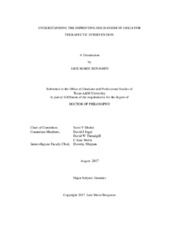| dc.description.abstract | Human chromosome 15q11-q13 contains a cluster of imprinted genes that are associated with a number of neurological disorders that exhibit non-Mendelian patterns of inheritance, such as Angelman syndrome (AS) and Prader-Willi syndrome. Angelman syndrome is caused by the loss-of-expression of maternally inherited ubiquitin E3A protein ligase gene (UBE3A). Prader-Willi syndrome is caused by loss-of-function of paternally inherited SNORD116 snoRNAs (small nucleolar RNAs), which are expressed as part of a long polycistronic transcriptional unit (PTU) comprised of SNURF-SNRPN, additional orphan C/D box snoRNA clusters, and the UBE3A antisense transcript (UBE3A-AS). The full-length transcript of PTU, including UBE3A-AS, is only expressed in neurons causing the imprinting of paternal UBE3A. Why this occurs in only neurons remains largely unknown. Furthermore, this neuron-specific imprinting adds additional difficulty for therapeutic intervention. In this dissertation, the imprinting mechanism of UBE3A is examined in detail, while an alternative high-throughput screening (HTS) method for drug discovery in neurons is developed.
A combination of bioinformatic and molecular analysis of the human and mouse PTU revealed that UBE3A-AS/Ube3a-AS is extensively processed via 5’ capping 3’polyadenyation and alternative splicing, suggesting that the antisense may have regulatory functions apart from imprinting UBE3A in neurons. Following this discovery, the transcriptional profiles and processing of mouse paternal Ube3a was investigated as literature suggested that imprinted paternal Ube3a, unlike other imprinted genes, was transcribed up to intron 4. This analysis unveiled a fourth Ube3a isoform that terminates within intron 4. Moreover, expression of this isoform correlated with Ube3a-AS expression, suggesting alternative reasons for the imprinting of Ube3a. In addition to the analysis of the imprinting of Ube3a, an alternative solution for drug discovery for central nervous system disorders was developed and validated. Here, an embryonic stem cell-derived neuronal culture system was developed for HTS and tested using the paternal Ube3a^Y FP reporter cell-line. Using a known reactivator of paternal Ube3a, Topotecan - a topoisomerase inhibitor, as a positive control a proof-of-concept study demonstrated the utility of this method for HTS drug discovery. Collectively, these results advance the field and understanding of antisense lncRNAs and provide a versatile tool for drug discovery for neurological disorders. | en |


